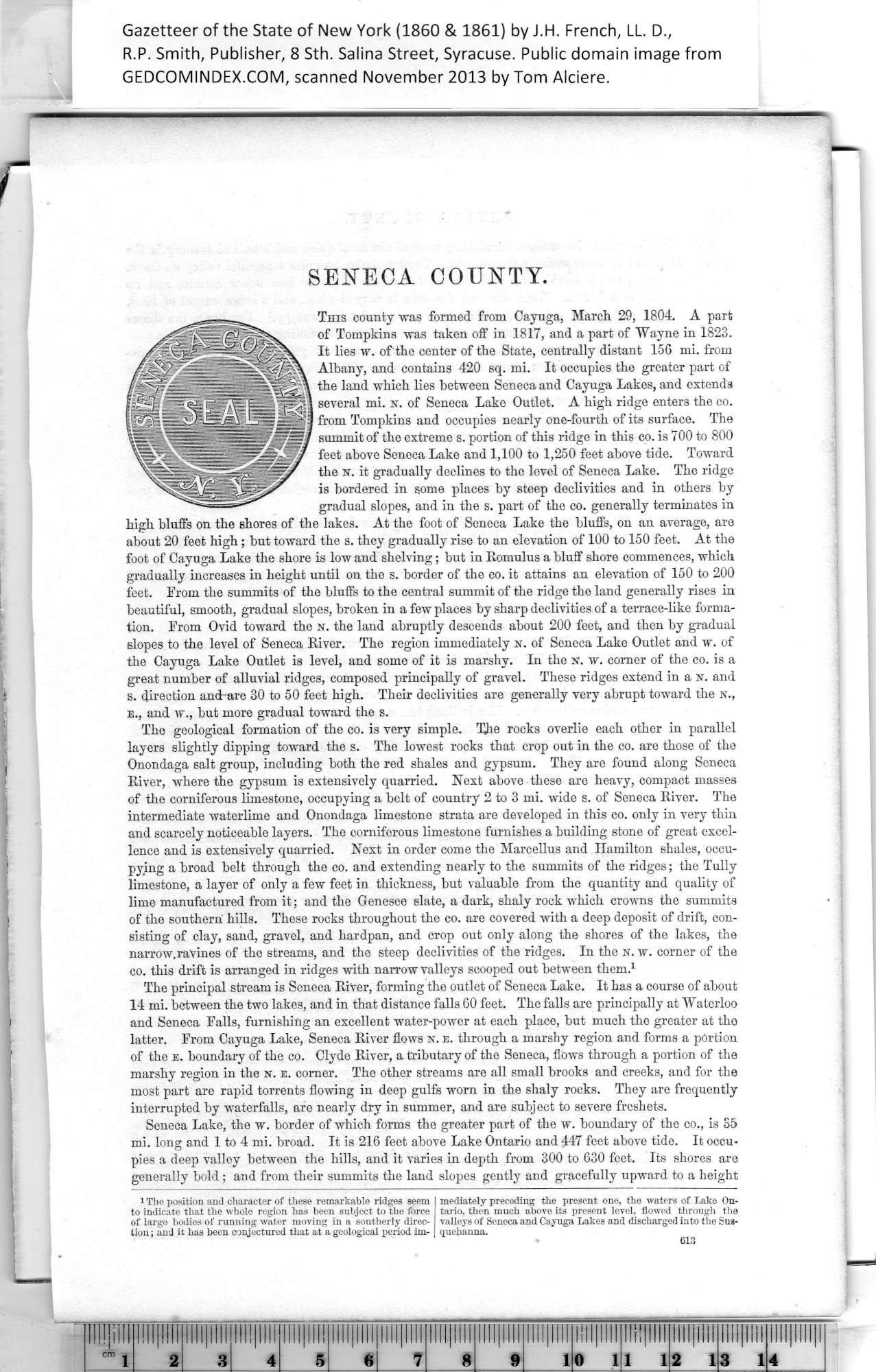|
SENECA COUNTY.
This county was formed from Cayuga, March 29, 1804. A part
of Tompkins was taken off in 1817, and a part of Wayne in 1823.
It lies w. of'the center of the State, centrally distant 156 mi. from
Albany, and contains 420 sq. mi. It occupies the greater part of
the land which lies between Seneca and Cayuga Lakes, and extends
several mi. n. of Seneca Lake Outlet. A high ridge enters the co.
from Tompkins and occupies nearly one-fourth of its surface. The
summit of the extreme s. portion of this ridge in this co. is 700 to 800
feet above Seneca Lake and 1,100 to 1,250 feet above tide. Toward
the n. it gradually declines to the level of Seneca Lake. The ridge
is bordered in some places by steep declivities and in others by
gradual slopes, and in the s. part of the co. generally terminates in
high bluffs on the shores of the lakes. At the foot of Seneca Lake the bluffs, on an average, are
about 20 feet high; but toward the s. they gradually rise to an elevation of 100 to 150 feet. At the
foot of Cayuga Lake the shore is low and shelving; but in Romulus a bluff shore commences, which
gradually increases in height until on the s. border of the co. it attains an elevation of 150 to 200
feet. From the summits of the bluffs to the central summit of the ridge the land generally rises in
beautiful, smooth, gradual slopes, broken in a few places by sharp declivities of a terrace-like forma¬
tion. From Ovid toward the n. the land abruptly descends about 200 feet, and then by gradual
slopes to the level of Seneca River. The region immediately sr. of Seneca Lake Outlet and w. of
the Cayuga Lake Outlet is level, and some of it is marshy. In the sr. w. corner of the co. is a
great number of alluvial ridges, composed principally of gravel. These ridges extend in a sr. and
s. direction and are 30 to 50 feet high. Their declivities are generally very abrupt toward the n.,
e., and w., but more gradual toward the s.
The geological formation of the co. is very simple. The rocks overlie each other in parallel
layers slightly dipping toward the s. The lowest rocks that crop out in the co. are those of the
Onondaga salt group, including both the red shales and gypsum. They are found along Seneca
River, where the gypsum is extensively quarried. Next above these are heavy, compact masses
of the corniferous limestone, occupying a belt of country 2 to 3 mi. wide s. of Seneca River. The
intermediate waterlime and Onondaga limestone strata are developed in this co. only in very thin
and scarcely noticeable layers. The corniferous limestone furnishes a building stone of great excel¬
lence and is extensively quarried. Next in order come the Marcellus and Hamilton shales, occu¬
pying a broad belt through the co. and extending nearly to the summits of the ridges; the Tully
limestone, a layer of only a few feet in thickness, but valuable from the quantity and quality of
lime manufactured from it; and the Genesee slate, a dark, shaly rock which crowns the summits
of the southern hills. These rocks throughout the co. are covered with a deep deposit of drift, con¬
sisting of clay, sand, gravel, and hardpan, and crop out only along the shores of the lakes, the
narrow.ravines of the streams, and the steep declivities of the ridges. In the n. w. corner of the
co. this drift is arranged in ridges with narrow valleys scooped out between them.1
The principal stream is Seneca River, forming the outlet of Seneca Lake. It has a course of about
14 mi. between the two lakes, and in that distance falls 60 feet. The falls are principally at Waterloo
and Seneca Falls, furnishing an excellent water-power at each place, but much the greater at tho
latter. From Cayuga Lake, Seneca River flows n. e. through a marshy region and forms a portion
of the e. boundary of the co. Clyde River, a tributary of the Seneca, flows through a portion of the
marshy region in the n. e. corner. The other streams are all small brooks and creeks, and for the
most part are rapid torrents flowing in deep gulfs worn in the shaly rocks. They are frequently
interrupted by waterfalls, are nearly dry in summer, and are subject to severe freshets.
Seneca Lake, the w. border of which forms the greater part of the w. boundary of the co., is 35
mi. long and 1 to 4 mi. broad. It is 216 feet above Lake Ontario and 447 feet above tide. It occu¬
pies a deep valley between the hills, and it varies in depth from 300 to 630 feet. Its shores are
generally bold ; and from their summits the land slopes gently and gracefully upward to a height
|
mediately preceding the present one, the waters of Lake On¬
tario, then much above its present level, flowed through the
valleys of Seneca and Cayuga Lakes and discharged into the Sus¬
quehanna. |
613
1
The position and character of these remarkable ridges seem
to indicate that the whole region has been subject to the force
of large bodies of running water moving in a southerly direc¬
tion; and it has been conjectured that at a geological period im¬
|
